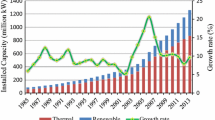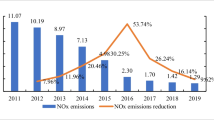Abstract
WIth the introduction of “carbon peak and neutrality” targets, China’s power industry is under enormous pressure to reduce carbon dioxide (CO2) emissions, as it produces more than 40% of emissions. In response, China’s power industry is actively reducing the investment in thermal energy and gradually shifting toward non-fossil energy sources. However, the CO2 reduction effect of these measures is still unknown. This study aims to analyze CO2 emissions from China’s power industry from 2009 to 2018 from an entire lifecycle perspective, considering that CO2 emissions also exist in non-fossil power generation. The logarithmic mean Divisia index (LMDI) method is employed to identify the factors influencing CO2 emissions. Then, the modified STochastic Impacts by Regression on Population, Affluence and Technology model is used for comparative validation. The results show that (1) CO2 emissions from China’s power industry increased significantly, from 276.5 million tons of CO2 equivalent (Mtce) in 2009 to 436.44 Mtce in 2018; (2) the investment intensity, investment structure, and emission intensity dampen CO2 emissions, with cumulative contribution rates of − 28.88%, − 11.89%, and − 3.16%, respectively. The investment efficiency, economic development level, and population size contribute to CO2 emissions, with cumulative contribution rates of 29.76, 24.68, and 1.07%, respectively; and (3) Investment into the hydropower contributes the least to CO2 emissions, followed by wind, nuclear, photovoltaic, and thermal power. These research findings suggest that the power industry should improve its investment decision-making capabilities and pay particular attention to the hydropower-led non-fossil energy sector.










Similar content being viewed by others
Data availability
Not applicable.
References
Acheampong AO, Amponsah M, Boateng E (2020) Does financial development mitigate carbon emissions? Evidence from heterogeneous financial economies. Energy Economics 88:104768. https://doi.org/10.1016/j.eneco.2020.104768
Ang BW (2004) Decomposition analysis for policymaking in energy: which is the preferred method? Energy Policy 32(9):1131–1139. https://doi.org/10.1016/S0301-4215(03)00076-4
Ang BW (2005) The LMDI approach to decomposition analysis: a practical guide. Energy Policy 33(7):867–871. https://doi.org/10.1016/j.enpol.2003.10.010
Ang BW (2015) LMDI decomposition approach: a guide for implementation. Energy Policy 86:233–238. https://doi.org/10.1016/j.enpol.2015.07.007
Ang BW, Liu FL (2001) A new energy decomposition method: perfect in decomposition and consistent in aggregation. Energy 26(6):537–548. https://doi.org/10.1016/S0360-5442(01)00022-6
Ang BW, Liu FL, Chew EP (2003) Perfect decomposition techniques in energy and environmental analysis. Energy Policy 31(14):1561–1566. https://doi.org/10.1016/S0301-4215(02)00206-9
Ang BW, Liu N (1997) Decomposition of aggregate energy and gas emission intensities for industry: a refined Divisia index method. Energy J 38(4):270. https://doi.org/10.1016/S0140-6701(97)85204-6
Ang BW, Liu N (2007) Handling zero values in the logarithmic mean Divisia index decomposition approach. Energy Policy 35(1):238–246. https://doi.org/10.1016/j.enpol.2005.11.001
Bowman DMJS, Kolden CA, Abatzoglou JT, Johnston FH, van der Werf GR, Flannigan M (2020) Vegetation fires in the Anthropocene. Nat Rev Earth Environ 1(10):500–515. https://doi.org/10.1038/s43017-020-0085-3
Bronselaer B, Zanna L (2020) Heat and carbon coupling reveals ocean warming due to circulation changes. Nature 585(7830):227–233. https://doi.org/10.1038/s41586-020-2765-z
Cansino JM, Román R, Ordóñez M (2016) Main drivers of changes in CO2 emissions in the Spanish economy: a structural decomposition analysis. Energy Policy 89:150–159. https://doi.org/10.1016/j.enpol.2015.11.020
Chen JD, Li ZW, Dong YZ et al (2020) Coupling coordination between carbon emissions and the eco-environment in China. J Clean Prod 276:123848. https://doi.org/10.1016/j.jclepro.2020.123848
Chen JD, Xu C, Cui L, Huang S, Song M (2019) Driving factors of CO2 emissions and inequality characteristics in China: a combined decomposition approach. Energy Econ 78:589–597. https://doi.org/10.1016/j.eneco.2018.12.011
Chen L, Duan Q (2016) Decomposition analysis of factors driving CO2 emissions in Chinese provinces based on production-theoretical decomposition analysis. Nat Hazards 84:267–277. https://doi.org/10.1007/s11069-016-2313-1
Chen YF, Lin BQ (2020) Decomposition analysis of patenting in renewable energy technologies: from an extended LMDI approach perspective based on three Five-Year Plan periods in China. J Clean Prod 269:122402. https://doi.org/10.1016/j.jclepro.2020.122402
Cui H, Zhao T, Wu RR (2018) CO2 emissions from China’s power industry: policy implications from both macro and micro perspectives. J Clean Prod 200:746–755. https://doi.org/10.1016/j.jclepro.2018.07.330
Du K, Lin B (2015) Understanding the rapid growth of China’s energy consumption: a comprehensive decomposition framework. Energy 90:570–577. https://doi.org/10.1016/j.energy.2015.07.079
Elliot T, Almenar JB, Rugani B (2020) Impacts of policy on urban energy metabolism at tackling climate change: the case of Lisbon. J Clean Prod 276:123510. https://doi.org/10.1016/j.jclepro.2020.123510
Feng C, Huang J-B, Wang M (2018) The driving forces and potential mitigation of energy-related CO2 emissions in China’s metal industry. Resour Policy 59:487–494. https://doi.org/10.1016/j.resourpol.2018.09.003
Fujimori S, Hasegawa T, Krey V et al (2019) A multi-model assessment of food security implications of climate change mitigation. Nat Sustain 2(5):386–396. https://doi.org/10.1038/s41893-019-0286-2
Hasan R (2021) Analysis of the drivers of CO2 emissions and ecological footprint growth in Australia. Energy Effi 15.https://doi.org/10.1007/s12053-021-10014-9
Huang F, Zhou D, Wang Q, Hang Y (2019) Decomposition and attribution analysis of the transport sector’s carbon dioxide intensity change in China. Trans Res Part A: Policy Pract 119:343–358. https://doi.org/10.1016/j.tra.2018.12.001
Huang Y, Yu Q, Wang RR (2021) Driving factors and decoupling effect of carbon footprint pressure in China: based on net primary production. Technol Forecast Soc Chang 167:120722. https://doi.org/10.1016/j.techfore.2021.120722
Khuong PM, McKenna R, Fichtner W (2019) Analyzing drivers of renewable energy development in Southeast Asia countries with correlation and decomposition methods. J Clean Prod 213:710–722. https://doi.org/10.1016/j.jclepro.2018.12.192
Li DZ, Huang GY, Zhang GM, Wang JB (2020a) Driving factors of total carbon emissions from the construction industry in Jiangsu Province China. J Clean Prod 276:123179. https://doi.org/10.1016/j.jclepro.2020.123179
Li JX, Chen YN, Li Z, Liu ZH (2018) Quantitative analysis of the impact factors of conventional energy carbon emissions in Kazakhstan based on LMDI decomposition and STIRPAT model. J Geog Sci 28(7):1001–1019. https://doi.org/10.1007/s11442-018-1518-5
Li W, Liu LG, Wang XY et al (2019) The analysis of CO2 emissions and reduction potential in China’s production and supply of electric and heat power industry: a case study based on the LMDI method. Environ Prog Sustain Energy 38(5):13192. https://doi.org/10.1002/ep.13192
Li X, Wang JM, Zhang M et al (2020b) Regional differences in carbon emission of China’s industries and its decomposition effects. J Clean Prod 270:122528. https://doi.org/10.1016/j.jclepro.2020.122528
Lima F, Nunes ML, Cunha J, Lucena AFP (2017) Driving forces for aggregate energy consumption: a cross-country approach. Renew Sustain Energy Rev 68:1033–1050. https://doi.org/10.1016/j.rser.2016.08.009
Liu D, Cheng RK, Li XR et al (2021) On the driving factors of China’s provincial carbon emission from the view of periods and groups. Environ Sci Pollut Res 28(37):51971–51988. https://doi.org/10.1007/s11356-021-14268-9
Liu HY, Gong GF (2021) Spatial-temporal analysis of China’s carbon intensity: a ST-IDA decomposition based on energy input-output table. Environ Sci Pollut Res 28(42):60060–60079. https://doi.org/10.1007/s11356-021-14877-4
Liu HY, Gong GF (2022) Heterogeneous impacts of financial development on carbon emissions: evidence from China’s provincial data. Environ Sci Pollut Res 29(25):37565–37581. https://doi.org/10.1007/s11356-021-18209-4
Liu H, Song Y (2020) Financial development and carbon emissions in China since the recent world financial crisis: evidence from a spatial-temporal analysis and a spatial Durbin model. Sci Total Environ 715:136771. https://doi.org/10.1016/j.scitotenv.2020.136771
Liu JX, Li HL, Liu TQ (2022) Decoupling regional economic growth from industrial CO2 emissions: empirical evidence from the 13 prefecture-level cities in Jiangsu Province. Sustainability 14(5):2733. https://doi.org/10.3390/su14052733
Liu Q, Mao CM, Tian F (2022b) Influencing factors of CO2 emissions in Chinese power industry: a study from the production and consumption perspectives. Comput Intell Neurosci 2022:3615492. https://doi.org/10.1155/2022/3615492
Mai LN, Ran QY, Wu HT (2020) A LMDI decomposition analysis of carbon dioxide emissions from the electric power sector in Northwest China. Nat Resour Model 33(4):e12284. https://doi.org/10.1111/nrm.12284
Nagashima F (2018) The sign reversal problem in structural decomposition analysis. Energy Econ 72:307–312. https://doi.org/10.1016/j.eneco.2018.04.027
Nie H, Kemp R (2013) Why did energy intensity fluctuate during 2000–2009? Energy Sustain Dev 17:482–488. https://doi.org/10.1016/j.esd.2013.06.001
Pan XF, Guo SC, Xu HT et al (2022) China’s carbon intensity factor decomposition and carbon emission decoupling analysis. Energy 239:122175. https://doi.org/10.1016/j.energy.2021.122175
Peng X, Tao XM (2018) Decomposition of carbon intensity in electricity production: technological innovation and structural adjustment in China’s power sector. J Clean Prod 172:805–818. https://doi.org/10.1016/j.jclepro.2017.10.236
Sadorsky P (2021) Wind energy for sustainable development: driving factors and future outlook. J Clean Prod 289:125779. https://doi.org/10.1016/j.jclepro.2020.125779
Sarkodie SA, Owusu PA (2021) Escalation effect of fossil-based CO2 emissions improves green energy innovation. Sci Total Environ 785:147257. https://doi.org/10.1016/j.scitotenv.2021.147257
Su B, Ang BW (2013) Input–output analysis of CO2 emissions embodied in trade: competitive versus non-competitive imports. Energy Policy 56:83–87. https://doi.org/10.1016/j.enpol.2013.01.041
Tenaw D (2021) Decomposition and macroeconomic drivers of energy intensity: the case of Ethiopia. Energ Strat Rev 35:100641. https://doi.org/10.1016/j.esr.2021.100641
Tian L (2021) The contribution of nuclear energy in a carbon neutral perspective. Energy 2021-05-05 (05):30–33. https://kns.cnki.net/kcms/detail/detail.aspx?FileName=NGYN202105006&DbName=CJFQ2021 (in Chinese)
Trnka M, Roetter RP, Ruiz-Ramos M et al (2014) Adverse weather conditions for European wheat production will become more frequent with climate change. Nat Clim Chang 4(7):637–643. https://doi.org/10.1038/NCLIMATE2242
Wang M, Feng C (2018) Using an extended logarithmic mean Divisia index approach to assess the roles of economic factors on industrial CO2 emissions of China. Energy Econ 76:101–114. https://doi.org/10.1016/j.eneco.2018.10.008
Wang M, Feng C (2021) The consequences of industrial restructuring, regional balanced development, and market-oriented reform for China’s carbon dioxide emissions: a multi-tier meta-frontier DEA-based decomposition analysis. Technol Forecast Soc Chang 164.https://doi.org/10.1016/j.techfore.2020.120507
Wang Q, Wang Y, Hang Y, Zhou P (2019) An improved production-theoretical approach to decomposing carbon dioxide emissions. J Environ Manage 252:109577. https://doi.org/10.1016/j.jenvman.2019.109577
Wang Q, Han X, Li R (2022) Does technical progress curb India’s carbon emissions? A novel approach of combining extended index decomposition analysis and production-theoretical decomposition analysis. J Environ Manage 310:114720. https://doi.org/10.1016/j.jenvman.2022.114720
Xie BC, Tan XY, Zhang S, Wang H (2021) Decomposing CO2 emission changes in thermal power sector: a modified production-theoretical approach. J Environ Manage 281:111887. https://doi.org/10.1016/j.jenvman.2020.111887
Xi JP (2020) Address to the General Debate of the 75th Session of the United Nations General Assembly. State Council Gazette of the People’s Republic of China 2020-10-10 (28):5–7. https://kns.cnki.net/kcms/detail/detail.aspx?FileName=GWYB202028002&DbName=CJFN2020 (in Chinese)
Xu SC, Zhou YF, Feng C, Zhang JN (2021) The factors of regional PM2.5 emissions inequality in China. Process Saf Environ Prot 150:79–92. https://doi.org/10.1016/j.psep.2021.04.005
Yan QY, Zhang Q, Zou X (2016) Decomposition analysis of carbon dioxide emissions in China’s regional thermal electricity generation, 2000–2020. Energy 112:788–794. https://doi.org/10.1016/j.energy.2016.06.136
Yang H, Lu ZN, Shi XP et al (2021) How well has economic strategy changed CO2 emissions? Evidence from China’s largest emission province. Sci Total Environ 774:146575. https://doi.org/10.1016/j.scitotenv.2021.146575
Zhao XC, Jiang M, Zhang W (2022) Decoupling between economic development and carbon emissions and its driving factors: evidence from China. Int J Environ Res Public Health 19(5):2893. https://doi.org/10.3390/ijerph19052893
Zhang M, Liu X, Wang WW, Zhou M (2013) Decomposition analysis of CO2 emissions from electricity generation in China. Energy Policy 52:159–165. https://doi.org/10.1016/j.enpol.2012.10.013
Acknowledgements
The authors are also grateful to the anonymous reviewer and editor for the careful scrutiny of the report and for the comments that helped improve this manuscript.
Funding
This work was supported by the National Natural Science Foundation of China (grant number 71701069) and the Fundamental Research Funds for the Central Universities (grant number 2020MS129).
Author information
Authors and Affiliations
Contributions
Xin Zou: methodology, resources, writing — review and editing. Jiaxuan Li: conceptualization, software, validation, investigation, data curation, writing — original draft. Qian Zhang: resources, writing — review and editing.
Corresponding author
Ethics declarations
Ethics approval
Not applicable.
Consent to participate
Not applicable.
Consent for publication
Not applicable.
Competing interests
The authors declare no competing interests.
Additional information
Responsible Editor: Ilhan Ozturk
Publisher's note
Springer Nature remains neutral with regard to jurisdictional claims in published maps and institutional affiliations.
Rights and permissions
Springer Nature or its licensor (e.g. a society or other partner) holds exclusive rights to this article under a publishing agreement with the author(s) or other rightsholder(s); author self-archiving of the accepted manuscript version of this article is solely governed by the terms of such publishing agreement and applicable law.
About this article
Cite this article
Zou, X., Li, J. & Zhang, Q. CO2 emissions in China’s power industry by using the LMDI method. Environ Sci Pollut Res 30, 31332–31347 (2023). https://doi.org/10.1007/s11356-022-24369-8
Received:
Accepted:
Published:
Issue Date:
DOI: https://doi.org/10.1007/s11356-022-24369-8




